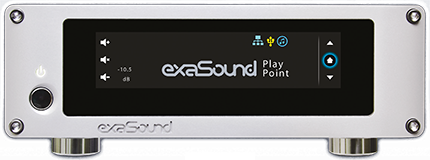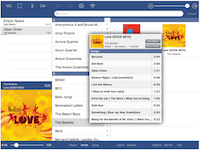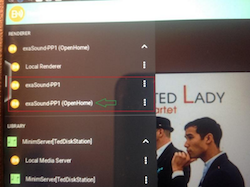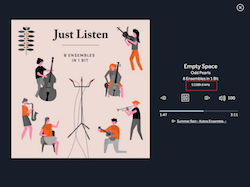
 The exaSound Playpoint Stereo/Multichannel Streamer
The exaSound Playpoint Stereo/Multichannel Streamer
(Jack of All Trades, Master of at Least Four!)
When the computer audiophile world began to embrace the onset of ethernet-based music streamers, it was slowly becoming clear that not all DACs could seamlessly take part in this (general use) computer-less setup. As
DAC manufacturers pushed for better and better integration with computers, some of them went as far as creating specific drivers to take advantage of direct handshaking with such higher resolution formats as raw
DSD (as opposed to getting one's
DSD packed in a
PCM carrier, aka
DoP). This integration often had sonic payoffs, but made plug-n-play Linux
UPnP streamers, looking for common drivers in the
USB Audio Class 2 category (aka UAC2) too pedestrian to be able to talk to these DACs. And although some of this has changed over the past couple of years (Linux code lines now embrace some native
DAC drivers of various manufacturers, above and beyond UAC2) some DACs still would rather interface more closely with proprietary drivers. One such
DAC manufacturer that has espoused this direct driver philosophy is exaSound.
This review is the third of my exaSound trilogy. I first reviewed the wonderful multichannel e28
DAC last year, then earlier this Spring I reviewed the high value e12 stereo
DAC. In both of those cases, one of the great benefits of using exaSound and my Windows music servers was the direct playback of up to raw DSD256 via exaSound's own ASIO driver. Through a combination of those proprietary drivers, proprietary volume control synchronization (JRiver, for example), and George Klissarov's company's innate knack for controlling and taming the powerful but often maligned ESS SABRE 9018 chips, these DACs screamed for inclusion into the new world of "computer-less" playback via Linux streamers (a category filled with such products as the Auralic Aries family, Sonore Rendu family, Aurender N series, etc). However, the proprietary nature of exaSound's philosophy made it difficult at first.
exaSound decided to build their own! Their customers demanded streamer capability, yet there was a real pushback on this concept if it didn't address three major goals:
- continue to extract raw DSD and PCM from the server; do not fall back to something less direct than ASIO
- allow for multichannel PCM and DSD playback up to 7.1 DSD256 to take advantage of the e28 and the new traction for available multichannel download sites
- must be plug-n-play, yet George wanted it to play in more than the UPnP world.
The exaSound PlayPoint is the name of this new offering. It is ethernet in (Wired or wireless),
USB out, and has a second
USB port that allows for local
USB storage (as MPD renderer). It claims to support up to 32/384k
PCM and DSD256, in both 2 channel and multichannel. There are no drivers to load. It acts as five different devices automatically (first come, first served):
- UPnP renderer (via any number of UPnP control points)
- MPD hardware player (using mPod or mPad on your Apple device, or dozens of other free clients in Windows, OSX, Android, etc)
- Open Home renderer (UPnP extensions developed by Linn; allows for "smarter" control points like Linn Kazoo, Auralic Lightning, Lumin, etc.)
- HQPlayer Network Audio Adapter (NAA) for dual pc FIFO buffering
- Apple Airplay Device (not tested)
The Playpoint (aka PP), like it's
DAC cousins, is a small form factor device that uses an external power supply (dc plug on back panel). The box is 6.5 x 2.2 x 9.25 inches (165 x 55 x 235 mm) and weighs 4 lbs (1.1Kg). The exaSound Playpoint will retail for $1999 and will be available almost immediately.
The PP has a touch screen on the front panel that allows for setup and customizations (channel trims in multichannel, choice of wired/wireless, main volume, playback metadata display, firmware upgrades, multiple PP zone identification, and others). The home screen icons confirm handshakes with either ethernet option,
USB dac connectivity and music playback. Once music begins playing, the screen changes to a classic playback screen with pause/ff/rew/stop icons, as well as time elapsed and a description of the format/sample-bit rate. (Note: I have done a couple firmware updates and they run glitch-free and take about 3-5 minutes to complete.)
So...exaSound owners..does this thing really work as they say it does? What does it sound like? Does it benefit from a linear power supply upgrade?
First off, although I have gone on record as not really liking or caring about front panel displays (cuz I listen 12 feet away from the front rack, and my eye chart talents left me years ago) I applaud exaSound for this use of touch screen, for setup and any troubleshooting. Since streamers typically exist as a replacement for using a general use computer as a server, there is usually a web interface or need for other clever computer-based setup tricks. None needed here. The touch panel, albeit small, is loaded with the necessary functions available on several pages (each page for each function). Moreover, George and Company have taken a K.I.S.S. approach to most of the complexity, thereby automatically switching between device functions simply based on the control point (remote control) used. If you fire up a
UPnP control point, the PP goes immediately into
UPnP mode and starts playback (assuming your
UPnP control point has found the device, usually known as "exaSound PP1"). So, use the touch panel for setup and channel trims, then rely on your lap-based control points. Done.
My primary excitement in reviewing this device was centered around the unique ability to stream multichannel music to my e28. (Note: ALL feedback here is identical for my weeks of 2 channel use via the e12 as well, but for now on I will reference multichannel content unless otherwise specified).
Mode 1 (PP as UPnP renderer)
What is required to do: have a
UPnP server installed somewhere (I have Minimserver on my Synology
NAS). Find a comfortable
UPnP control point (I use BubbleUPnP on my Android tablet).
The PP was immediately found by BubbleUPnP, and away I went. And due to my multichannel setup where I have now eschewed the notion of an additional multichannel analog preamp and instead go direct (e28
DAC direct to amps, except front speakers which passthru stereo preamp unity gain untouched) I find that using the synchronized volume control of the e28 to be the most musical and revealing. What is nice is that this integration is automatic in the PP, so I adjust native e28 volume via the Bubble app. It is seamless, clean and very very musical. During the extensive evaluation I experienced no dropouts or glitches on anything up to
5.1 DSD256. How does it sound? Great! Of course, I have nothing to really compare it to, except computer-based playback via JRiver and JRemote. The sound is identical, using significantly less pieces of equipment.
Plug-and-play rating of 9 (out of 10), due simply to the bare bones nature of
UPnP, and the tight integration of the PP and the e28.
Mode 2 (PP as MPD hardware player)

What is required to do: put music on a USB hard drive, plug it in the back of the PP, and download any number of MPD clients (I use mPad for the iPad).
I must note that the local
USB/MPD handshake is a simple one, and that exaSound has promised later
NAS integration via the ethernet (which will either require an additional touch screen page or a web interface).
I love the mPad interface (reminds me of Apple's Remote app) and find MPD to be incredibly quick to find and load music. Once again, the volume slider on mPad is fully integrated with the e28 volume control so one is not degrading by going through multiple volumes, etc. And although my local
USB drive consisted of a noisy 3.5"
HDD toaster, I could hear nothing but pitch black backgrounds from this setup. It is a true minimalist's dream, and sounds as good as the Minimserver
UPnP setup above. The choice is yours! The only downside is that MPD likes to find cover art in the music folders (i.e. folder.jpg) so if your library is not set up that way then a quick MP3Tag extract project (takes embedded art and creates a folder.jpg in each album folder...takes only a few minutes) might be a good thing. There is no real downside to this approach, and
IMHO sets up your library for fewer cover art glitches down the line (as many software players look to cover.jpg first for their art).
Plug-and-play rating: 10 (if library is already local and cover art is already set), 7 otherwise.
Mode 3 (PP as Open Home Renderer)
What is required to do: install BubbleServer on the same machine as your Minimserver, then add 'exaSound PP1" as an Open Home copy in Bubble's setup screen. Takes a total of 2 minutes.
Linn created the Open Home extension to
UPnP to allow for smarter streaming. For example, playlists (either saved or current album in use) now become viewable from any and all control points, as they are owned by the PlayPoint, not by the control point. Like going from one networked DVR in your house to a second one, and resuming movie playback. Also, more elegant control points are available to see the newly created "PP1-OpenHome" on the network. (I use Linn Kazoo for all my OH playback, or occasionally on the Android).


As with the earlier modes, volume integration is available on the control points (Kazoo's bizarre volume knob takes 5 minutes and nearly 100 revolutions to go from 0-100 but oh well).
Plug-and-play rating: 7, simply due to the fact that additional software (BubbleServer) is required to install. This rating has nothing to do with PP, and would be my rating on any other
UPnP renderer, assuming it also needs no further setup (BIG assumption).
In all three of these streamer modes, my vast collection of
DVD-Audio rips, SACD rips, DSD128 and 256 multichannel downloads...all played glitch-free and were available for browsing from my iPad app of choice (I used an Android tablet for simple
UPnP but could have used an iPad-based Kinsky, for example). Once I had my channel trims (left, center, right, surround left, surround right, subwoofer) calibrated on the PP touch panel (again, synched to the e28 internal trims) I simply sat back and chose any mode I wanted; the modes were chosen simply based on the remote used. (Note; best practices says one should stop, not pause, the music file playback before attempting to go from one control point to the other).
As I like to classify surround mix categories, there are two clearly distinct ones in my mind:
1)
Acoustic (recorded live with acoustic instruments, capturing detail, tone and hall ambience and dynamics. The goal here is minimalism, analog mixes to native
DSD A to D. Whether it be Jared's wonderful master recordings of Rachel Podger, Ivan Fischer and the BFO, or earlier fave Pieter Wispelwey...the NativeDSD (and Channel SACD rips)_files sounded incredible. As readers know, I am proud to volunteer my time to be part of the Native team, but would say this about the recordings regardless. The Playpoint/e28 combination is incredible here, and I am transported to each venue.
What was especially fun was the ability to play back DSD256 recordings like the Ensemble in 8 Bits sampler that shows off this recording technique using small quartets, acapella ensembles, jazz duos and modern classical upstarts from the local Dutch music industry. The tonality is spectacular.
2)
Adventure (mixed aggressively in all 5 channels, plus
LFE, using existing highly produced multitrack content to allow more of the layers of the production to shine through, often using rear channels as aggressively as the front three). My heroes in this category begin with Elliot Scheiner and his work with Beck, Donald Fagen and Steely Dan, to name three. Through the PP/e28 the dynamics are present all around you, yet it's not ping-pong or Star Wars effects. Scheiner's mixes are more logical and content-based than that. Listening to Beck's Sea Change via the Playpoint allowed me to hear all the growl, the grunt, and the off-tone effects of Beck's relationship-split masterpiece as they were intended. His sweet and sour approach to tonality is appreciated in the nice MFSL stereo mix, but the
DSD (or DVD_A version) enveloped you in all the synth-string and twangy heartache, and it's quite a musical voyage. I find the subtle cues are much more evident in this simpler signal path (
NAS-PP-
DAC) than in the former JRiver multichannel playback (WindowsServer 2012, etc).
Mode 4 (PP as HQPlayer NAA)
What is required to do: install and use HQPlayer on a computer on your network.
This mode is strictly for users of the Signalyst HQPlayer software. The NAA architecture basically says to use a hefty computer for all the heavy lifting of HQPlayer (upsampling, music browsing, etc) and then use a lightweight computer/device as the FIFO buffer to the
DAC, thereby isolating that galvanically from what could potentially be a general use noisy HQPlayer computer. The PP is seen, automatically, by HQPlayer is an NAA device. Pick it in the HQPlayer menu and you are done!
My current NAA is a
CAPS Carbon with JCAT
USB card. Is this Playpoint it's equal sonically? I would say it's very very close, say 98% of the JCAT machine (the PP has ever so slightly more etched leading edge, and ever so slightly less weight in the lowest registers, yet seems to have a very slightly more tonal midrange, frankly). Yes, those last 2% can be important, but boy do they risk requiring great care and feeding, not to mention cost. So, if you are a tweaker that needs that last drop (as I often am) then the last 2% might be well worthwhile. But to the more reasonable voices in us, it's really very much a mood thing (i.e. life is too short mood).
By the way, the PP as NAA was able to easily stream DSD256 in
5.1 and handle any HQP upsampling to DSD64
5.1 (although I tend to leave my multichannel
PCM in
PCM).
Mode 5 (PP as Airplay device)
This is likely the simplest setup yet, but I did not have my Mac Mini available, so this will wait until later to truly confirm. Given what I have confirmed it is already capable of, I can't imagine Airplay being an obstacle.
Summary
This is a somewhat difficult product to review in that I like to give readers a lot of options and comparisons. Instead, this PlayPoint itself gives the readers lots of options, and since exaSound DACs don't talk to Aries or Rendu streamers, nor does the PP talk to other DACS, the comparisons are only as I stated them in this article.
All that being said, this box is a no-brainer to evaluate if you are an exaSound
DAC owner, and a clearly unique approach to multichannel streaming for those who haven't bought a system. It does everything it's advertised to do, runs in 3-4 different scenarios, and is built very well, too.
For those without exaSound DACS, put pressure on exaSound to eventually open this PP up to other DACs! Could be good for everybody concerned. There are already announced free updates coming, such as Roon support (RoonSpeaker).
One not-yet-final thought: I have had no time to yet compare linear power supplies. I am currently using the Sbooster BOTW 12-13a supply (they so kindly loaned me two of them, plus SBooster Pluses) and it sounds extremely good and seems to impart even a lower noise floor and better heft...but that is purely a first impression, with no a/b comparison to the stock supply, since I needed 100 hours to break this SBooster in anyway. The conventional wisdom says that the linear power upgrades are likely more effective on the
DAC, but I've been surprised more than once on how aspects of computer audio can be almost counter-intuitive. I will update this review (and post in the thread below) when I know more.
Thanks for reading,
Ted Brady
Product Information:
- Product - exaSound PlayPoint
- Price - $1,999
- Product Page - Link

- User Manual - Link (PDF)
